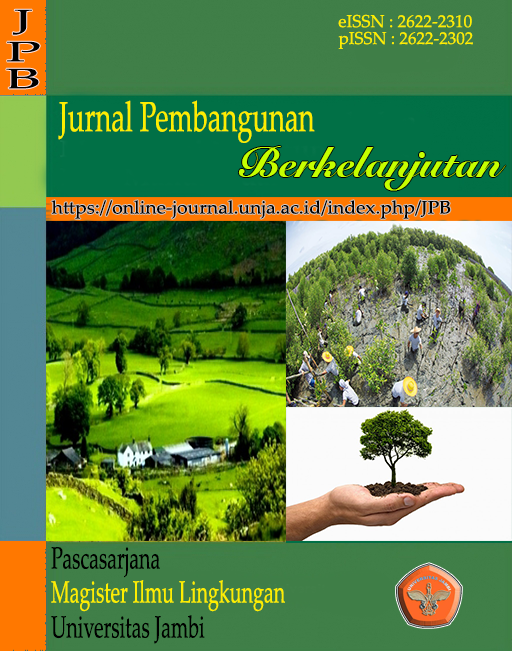ANALISIS KEBERLANJUTAN USAHATANI SAYURAN KANGKUNG DI KECAMATAN PAAL MERAH KOTA JAMBI
DOI:
https://doi.org/10.22437/jpb.v3i2.8906Keywords:
Analisis, Keberlanjutan, Usahatani, SayuranAbstract
This study aims to describe farming activities kale in District Paal Merah city of Jambi, knowing sustainability index farm kale from the dimensions of the ecological, economic and social, as well as to determine the factors that affect adoption of sustainable farming kale in District Paal Merah city of Jambi. Methods of data analysis using descriptive analysis and quantitative analysis using MDS (Multi Dimension Scale) doped with Rapfish application. In addition, to determine the factors that affect the linear regression.
The result showed that: (1) The results of the analysis of vegetable farming income in the study area showed that vegetable farming that farmers provide benefits for farmers. The average farmer's income earned in the District of Paal Red kale Rp. 1.231.125,67;-, with the cost of Rp. Rp. 910.728,50;- and the reception received by farmers Rp 2.141.854,17;-. (2) The results of the analysis of the value of sustainable farming in the district kale Red Paal at 61.42. The figure shows the level of integration of sustainability kale farm in the District of Red Paal quite sustainability. With the analysis of the ecological dimensions of sustainability index of 71.27%, 57.10% of the economic dimension and the social dimension of 55.88%. (3) Based on the results of t-test analysis showed that, the value of sustainable farming in the district kale Red Paal farmers are affected by age. When viewed from the significance value then age watercress farmers have significant influence with age farmers. While the experience factor, farmers' income and education did not significantly affect the farmers to adopt sustainable farming values kale.
Keywords: farming kale, sustainability index, factors that affecting
Downloads
Downloads
Published
How to Cite
Issue
Section
License
Copyright (c) 2020 Jurnal Pembangunan Berkelanjutan

This work is licensed under a Creative Commons Attribution 4.0 International License.
1. Authors retain copyright and grant the journal right of first publication with the work simultaneously licensed under a Creative Commons Attribution 4.0 International License that allows others to share the work with an acknowledgement of the work's authorship and initial publication in this journal.
2. Authors are able to enter into separate, additional contractual arrangements for the non-exclusive distribution of the journal's published version of the work (e.g., post it to an institutional repository or publish it in a book), with an acknowledgement of its initial publication in this journal.
3. Authors are permitted and encouraged to post their work online (e.g., in institutional repositories or on their website) prior to and during the submission process, as it can lead to productive exchanges, as well as earlier and greater citation of published work (The Effect of Open Access)











